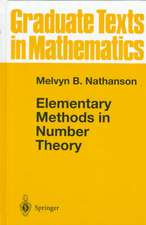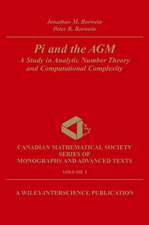Introduction to Analytic Number Theory: Grundlehren der mathematischen Wissenschaften, cartea 148
Autor Komaravolu Chandrasekharanen Limba Engleză Paperback – mar 2012
Din seria Grundlehren der mathematischen Wissenschaften
-
 Preț: 353.84 lei
Preț: 353.84 lei - 18%
 Preț: 723.26 lei
Preț: 723.26 lei -
 Preț: 410.21 lei
Preț: 410.21 lei - 24%
 Preț: 587.87 lei
Preț: 587.87 lei - 17%
 Preț: 498.73 lei
Preț: 498.73 lei -
 Preț: 592.75 lei
Preț: 592.75 lei - 24%
 Preț: 893.28 lei
Preț: 893.28 lei - 20%
 Preț: 824.73 lei
Preț: 824.73 lei - 24%
 Preț: 632.96 lei
Preț: 632.96 lei - 15%
 Preț: 584.63 lei
Preț: 584.63 lei - 15%
 Preț: 700.05 lei
Preț: 700.05 lei -
 Preț: 333.01 lei
Preț: 333.01 lei - 15%
 Preț: 463.61 lei
Preț: 463.61 lei -
 Preț: 349.35 lei
Preț: 349.35 lei -
 Preț: 474.65 lei
Preț: 474.65 lei - 15%
 Preț: 443.67 lei
Preț: 443.67 lei -
 Preț: 447.46 lei
Preț: 447.46 lei - 15%
 Preț: 694.42 lei
Preț: 694.42 lei -
 Preț: 414.57 lei
Preț: 414.57 lei - 15%
 Preț: 435.33 lei
Preț: 435.33 lei - 15%
 Preț: 517.16 lei
Preț: 517.16 lei - 15%
 Preț: 577.75 lei
Preț: 577.75 lei -
 Preț: 346.30 lei
Preț: 346.30 lei - 18%
 Preț: 712.93 lei
Preț: 712.93 lei -
 Preț: 380.17 lei
Preț: 380.17 lei - 15%
 Preț: 445.58 lei
Preț: 445.58 lei - 15%
 Preț: 471.31 lei
Preț: 471.31 lei -
 Preț: 455.19 lei
Preț: 455.19 lei -
 Preț: 341.78 lei
Preț: 341.78 lei -
 Preț: 354.78 lei
Preț: 354.78 lei -
 Preț: 478.30 lei
Preț: 478.30 lei - 15%
 Preț: 438.54 lei
Preț: 438.54 lei -
 Preț: 411.37 lei
Preț: 411.37 lei -
 Preț: 380.72 lei
Preț: 380.72 lei -
 Preț: 410.79 lei
Preț: 410.79 lei - 15%
 Preț: 569.27 lei
Preț: 569.27 lei -
 Preț: 487.73 lei
Preț: 487.73 lei -
 Preț: 353.28 lei
Preț: 353.28 lei -
 Preț: 379.96 lei
Preț: 379.96 lei -
 Preț: 411.37 lei
Preț: 411.37 lei - 18%
 Preț: 711.07 lei
Preț: 711.07 lei -
 Preț: 444.63 lei
Preț: 444.63 lei -
 Preț: 378.63 lei
Preț: 378.63 lei -
 Preț: 352.33 lei
Preț: 352.33 lei
Preț: 705.52 lei
Preț vechi: 860.38 lei
-18% Nou
Puncte Express: 1058
Preț estimativ în valută:
135.07€ • 140.39$ • 111.98£
135.07€ • 140.39$ • 111.98£
Carte tipărită la comandă
Livrare economică 06-20 februarie 25
Preluare comenzi: 021 569.72.76
Specificații
ISBN-13: 9783642461262
ISBN-10: 3642461263
Pagini: 152
Ilustrații: VIII, 144 p.
Dimensiuni: 155 x 235 x 8 mm
Greutate: 0.23 kg
Ediția:Softcover reprint of the original 1st ed. 1968
Editura: Springer Berlin, Heidelberg
Colecția Springer
Seria Grundlehren der mathematischen Wissenschaften
Locul publicării:Berlin, Heidelberg, Germany
ISBN-10: 3642461263
Pagini: 152
Ilustrații: VIII, 144 p.
Dimensiuni: 155 x 235 x 8 mm
Greutate: 0.23 kg
Ediția:Softcover reprint of the original 1st ed. 1968
Editura: Springer Berlin, Heidelberg
Colecția Springer
Seria Grundlehren der mathematischen Wissenschaften
Locul publicării:Berlin, Heidelberg, Germany
Public țintă
ResearchCuprins
I The unique factorization theorem.- § 1. Primes.- § 2. The unique factorization theorem.- § 3. A second proof of Theorem 2.- §4. Greatest common divisor and least common multiple.- § 5. Farey sequences.- § 6. The infinitude of primes.- II Congruences.- § 1. Residue classes.- § 2. Theorems of Euler and of Fermat.- § 3. The number of solutions of a congruence.- III Rational approximation of irrationals and Hurwitz’s theorem.- § 1. Approximation of irrationals.- § 2. Sums of two squares.- § 3. Primes of the form 4k±.- §4. Hurwitz’s theorem.- IV Quadratic residues and the representation of a number as a sum of four squares.- § 1. The Legendre symbol.- § 2. Wilson’s theorem and Euler’s criterion.- § 3. Sums of two squares.- § 4. Sums of four squares.- V The law of quadratic reciprocity.- § 1. Quadratic reciprocity.- § 2. Reciprocity for generalized Gaussian sums.- § 3. Proof of quadratic reciprocity.- § 4. Some applications.- VI Arithmetical functions and lattice points.- § 1. Generalities.- § 2. The lattice point function r(n).- § 3. The divisor function d(n).- § 4. The functions ?(n).- § 5. The Möbius functions ?(n).- § 6. Euler’s function ?(n).- VII Chebyshev’s therorem on the distribution of prime numbers.- § 1. The Chebyshev functions.- § 2. Chebyshev’s theorem.- § 3. Bertrand’s postulate.- § 4. Euler’s identity.- § 5. Some formulae of Mertens.- VIII Weyl’s theorems on uniforms distribution and Kronecker’s theorem.- § 1. Introduction.- § 2. Uniform distribution in the unit interval.- § 3. Uniform distribution modulo 1.- § 4. Weyl’s theorems.- § 5. Kronecker’s theorem.- IX Minkowski’s theorem on lattice points in convex sets.- § 1. Convex sets.- § 2. Minkowski’s theorem.- § 3. Applications.- XDirichlet’s theorem on primes in an arithmetical progression.- § 1. Introduction.- § 2. Characters.- § 3. Sums of characters, orthogonality relations.- § 4. Dirichlet series, Landau’s theorem.- § 5. Dirichlet’s theorem.- XI The prime number theorem.- § 1. The non-vanishing of ? (1 + it).- § 2. The Wiener-Ikehara theorem.- § 3. The prime number theorem.- A list of books.- Notes.














